About this Blog: There are some places that you simply want to visit. Phugtal Monastery was one such place. Also known as the cave monastery, Phugtal Monastery, also known as Phuktal Monastery and Phuktar Gompa is located in a remote part of Zanskar Valley in Ladakh and can be reached only by trekking. In this blog, we share about our experience of Phugtal Monastery trek and other important information on how to reach and where to stay about Phugtal Monastery.
The first time I saw a photograph of the monastery, I knew that I had to be there. That was almost 8 years ago when I first saw a photograph of the monastery when we had been on our first Ladakh trip. A monastery hidden inside a remote cave. I had heard that the only way to reach Phugtal Monastery was by trekking for 3-4 days. The monastery looked so remote and intriguing. And hence started my plans for visiting Phuktal Monastery and in turn working upon planning a trip to Zanskar, one of the least visited destinations in India.

Well, as of today, it does not take a 3-day trek to reach Phuktal Monastery. Now we can reach the monastery by a 2-3 hours hike only. And there are two ways to reach there. So finally, we were standing in front of the Phutkal Monastery, also known as Phugtal Gompa or Phuktar Gompa, looking in awe and wondering what took us 8 years to finally visit this place!
Phugtal Monastery
The monastery emerges from a mountain side on a part of the gorge on the Tsarap Chu, a major tributary of the Zanskar River. From a distance, it looks like a massive honeycomb. In fact, some also call Phugtal monastery as the “Honeycomb Monastery” as well as the cave monastery. If you thought monasteries house a sense of mystery in them, then Phugtal Monastery is sure to conform to this belief. Rich in history and legend, the architecture is ancient and rustic. Phugtal Monastery is simply grand and beautiful and intriguing. No wonder, it is known as the stairway to heaven.

The monastery now houses around 100 monks and still remains one of the most remote places to visit in Zanskar.
Phuktar Monastery gets disconnected from the world in winters due to heavy snowfall. Infact, Zanskar gets disconnected from other parts of Ladakh during the winters due to heavy snowfall. The roads get blocked and the only way to access Zanskar during the winters is walking over the frozen Zanskar River. Well, that is the Chadar Trek, where people reach Padum, the capital city of Zanskar by walking over the frozen river.
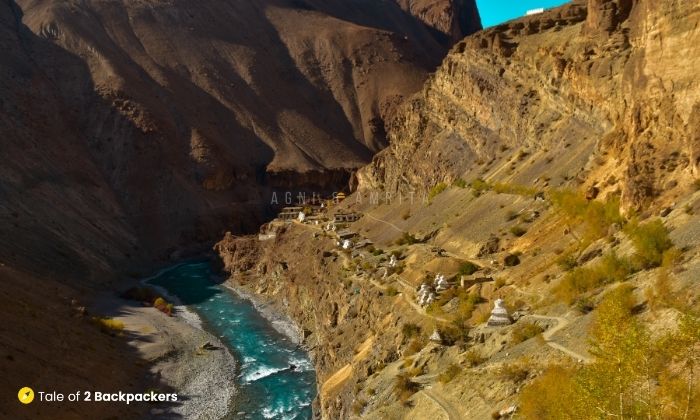
As a result, Phugtal monastery is also disconnected from the rest of the world during the winters. During the summers, supplies are usually transported to the monastery by mules and horses.
READ HERE TO KNOW ABOUT HOW TO REACH ZANSKAR VALLEY
There are talks of constructing an all-weather road to Zanskar by the Government. We also heard that an airport is also going to be constructed here. But those are in the future.
Where is Phugtal Monastery Located?

Phugtal Monastery or Phugtal Monastery is located in one of the remotest parts of Zanskar in Ladakh. The monastery is located in a remote corner of Lungnak Valley in the south-eastern part of Zanskar Valley. You can reach the monastery by trekking either from Purne village or Chah village. I will talk more about how to reach the monastery later in this article.
Phugtal Monastery – History
The first thing that came to my mind when I saw this wonderful place was how this monastery was built in such a remote place. And then it came to my mind that most of the Buddhist monasteries are usually built in such remote places.

The history of Phugtal Monastery almost dates back to 2500 years ago. It is believed that almost 2500 years ago, the monastery was just a cave in the mountains where Buddhist monks or anyone seeking enlightenment used to meditate in complete isolation. Infact, “Phuk” means ‘cave’ and “tal” means ‘liberation’.
Historical scriptures speak about three brothers Dangson, Pun and Sum. They were blessed with the supernatural gift of flying. They had preached their Dharma teachings at this place and then later bequeathed this sacred place to Jangsem Sherap Zangpo, a Tibetan Buddhist Guru. The Phugtal monastery was founded by Jangsem Sherap Zangpo in the early 15th century.

Zangpo was the follower of Gelug School of Tibetan Buddhism, founded by Je Tsongkhapa. Local folklore states that Tsongkhapa had instructed Zangpo to spread the teachings of Buddhism in Ladakh. He instructed Zangpo to give the King of Ladakh with a drop of Tsongkhapa’s blood and bone powder. The Ladakhi King was all but happy to help Zangpo in propagation of Buddhism in Ladakh.
YOU MAY ALSO LIKE: ZANSKAR VALLEY – EXPECTATIONS AND EXPERIENCES
It is believed that Zangpo expanded the cave and divined a spring to run in the cave and a tree to grow on top of the cave. We did see a juniper tree on top of the cave and the locals consider the tree to be quite sacred.
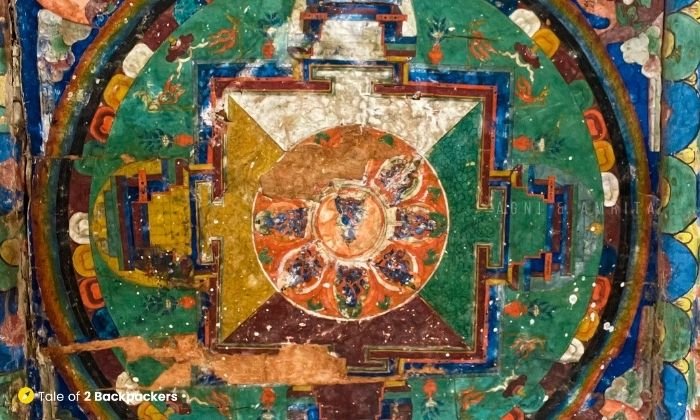
The monastery was hidden from the rest of the world until the 19th century when the Hungarian historian Alexander Csoma de Koros visited this place in 1826-1827. He was the pioneer in Tibetan studies and it is believed that he made the first Tibetan- English dictionary during his stay in Zanskar.
Phugtal Monastic School

Phugtal Monastic School has been built to provide education to students of the local villages. The school provides education in traditional learning as well as modern curriculum. The monastery provides the education free to the students and also bears the cost of their stay, food and study materials.
The lamas enter the monastery at a very young age, some at the age of 5 years. They are taught Buddhism and philosophy along with other modern subjects.

What is the best time to visit Phugtal Monastery?
The best time to visit Phugtal monastery is during the summer months between June to September. The roads to Padum remain open during this time. The first 2 weeks of October is also a good time to visit.

We had visited in the first week of October and found the weather quite pleasant. There was chill in the air and the sun was not harsh as during the summer months. The evening and night were, however, quite cold. So, if you are planning to visit during the first weeks of October, do not forget to carry your winter clothes.
However, after the second week of October, cold starts setting in and the high Himalayan passes receive snowfall. Infact, when we returned from Leh on 20th October, all the high passes leading to Zanskar were closed due to snowfall.
How to reach Phugtal Monastery?
Earlier, to visit Phugtal monastery, you would have to reach Padum. But with the new road being opened from Darcha to Padum, you can access Phugtal Monastery via Purne village without reaching Padum.
Route 1
Manali – Darcha – Shinku La – Purne – Phugtal Monastery
Starting from 2020, you can reach Zanskar Valley from Manali and Darcha via the Shinku La Pass. This new route offers some great views on the road with staggering landscape. But the road conditions are not yet good and be ready for an adventurous off-roading trip if you are taking this route.
Through this route, you will reach Purne village and from there you can trek to Phugtal Monastery. The trek from Purne will take about 2 hours to reach Phugtal Monastery.
You can come back to Darcha by the same route if you do not plan to go further into Zanskar.

Route 2
Padum – Purne – Phugtal Monastery
You can also start from Padum, drive to Purne and then start the trek towards Phugtal Monastery. Padum to Purne will take about 2-3 hours on the road and then you have to trek.
Route 3
Padum – Chah – Phugtal Monastery
This is the route we took. Start from Padum and reach Chah village. The drive is around 2- 2.5 hours. From Chah, it is about a 2-3 hours trek to Phugtal Monastery. We took about 3.5 hours to reach the monastery after taking sufficient photography breaks.

3 Days Trek Itinerary to Phugtal Monastery
There is also a 3-day trek route starting from Ichar village. If you are interested in this traditional trekking route, you can reach Ichar from Padum.
Day 1: Padum – Ichar – Anmu – Chah
- Start early from Padum to reach Ichar (1.5 hours drive)
- Start your trek from Ichar to Anmu. It will take about 6 hours. If you have less time, you can trek upto Chah (another 2 hours trek)
- A few Homestays are available at Anmu and Chah.
Day 2: Chah – Phugtal Monastery – Purne
- Start early from Chah towards Phugtal Monastery (2-3 hours trekking)
- Explore the monastery
- Start from Phugtal and trek back to Purne (2-3 hours trek)
- Homestays are available at Purne.
Day 3: Purne – Anmu – Ichar – Padum
- Start your trek from Purne to reach Ichar (7-8 hours trek)
- From Ichar, drive back to Padum.
Phugtal Monastery Trek – Our Experience
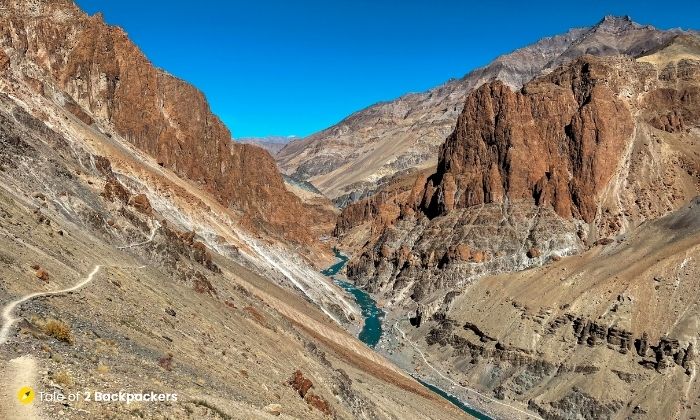
This place had been on our radar for a long time. Quite naturally, we were quite excited for the Phugtal Monastery trek. We started from Padum, the largest town in Zanskar early in the morning towards Chah village.
As mentioned earlier, these days there are two ways to reach Phugtal Monastery – one through Purne village and the other through Chah. These two roads start from two different villages, but actually run on either side of the Tsarap River. So, you can actually see the other trail while hiking on the other one.
The trek route from Purne is the traditional one and is mostly taken by the trekkers. The time taken through this trail is also a few minutes less than the trail through Chah. Also, Purne has better accommodation facilities than Chah. So if you are planning to stay somewhere before the trek, it is better to stay at Purne.
We took the trail from Chah.
Recently, roads are being constructed near Purne village. Because of this, some parts of the trail (at the start of the trek) are almost non-existent. You literally have to crawl around these areas. So, we decided to take the trekking trail from Chah.
Padum – Chah
It took us about 2 hours from Padum to reach Chah. We drove through the rugged roads of Zanskar. The first half hour of the drive was quite good, but then the roads started getting rough and meaner. As we crossed Ichar and Anmo, I realized that only a couple of years back, Phugtal monastery trek used to start from Ichar village. Roads have been developed since.
Finally, we reached Chah. The motorable road ends at Chah village.
Chah – Phugtal Monastery (Trek)

From the start of the trekking trail, we could see Purne village on the other side of the Tsarap River. The river looked beautiful with the glittering turquoise water running between the gorges. A first look at the river and the mountains definitely made our day and we were ready to start our trek towards the Phugtal Monastery.
The trekking trail is fairly easy. There was a gradual uphill and downhill trail. We could see the trail from Purne on the other side of the river. Here we realized that the trail from Purne has more gradients. While the trail from Chah is gradual, the trail from Purne is steeper and more dramatic.

After trekking, taking photographs, we finally got our first glimpse of the monastery gate. Well, the monastery was still hidden from our sight, we could only see the get. Tashi, our friend and guide from Zanskar jokingly told us that it is another 45 minutes trek to the monastery. Of course, he was joking.
Another few minutes of trek and we reached near the Tsarap River bed. This is the place where both the trails from Chah and Purne meet. There is a wooden bridge here. Prayer flags flutter around the place and give it such a calming ambience.

The wooden bridge, known as the Phugtal Bridge connects the two banks of the Tsarap River. If you are coming from Purne, then you have to cross a bridge and then take the trail towards the monastery.
There is another rickety bridge over the river that looks quite dangerous to cross. You need to be brave to cross the bridge over the flowing Tsarap River. Earlier this was the bridge that you had to cross to reach the monastery. Landslides in 2015 literally washed away the bridge. Later the wooden bridge was constructed that looks stronger and better.
We had lunch by the river side and then started our trek towards the monastery. It did not take 45 minutes, but within 20 minutes, we were near the Phugtal Monastery gate.

As we entered and walked a few steps ahead, we got the first glimpse of the Phugtal Monastery.
Whoa! That was the only thing I could say as I got the first glimpse of the honeycomb monastery. It was almost 2 PM, a strong breeze was blowing and we both were literally staring at the scene in front of us in awe.

How could they build such a monastery in such a place? That was on our mind. We stopped, we looked, we admired and felt ecstatic after visiting the place that we wanted after so long. We were all smiles.
Staying at the monastery guest house

We had decided to stay the night at Phugtal monastery. There are 2 guest houses at the monastery – one run by the government and the other run by the monastery itself. The guesthouse run by the monastery was under renovation, so we stayed at the other one.
We reached the guest house, kept our luggage and went to visit the Phuktar Monastery. The monastery was another 5-7 minutes walk from the guest house. We reached the monastery, took some photographs and returned back to our guest house.
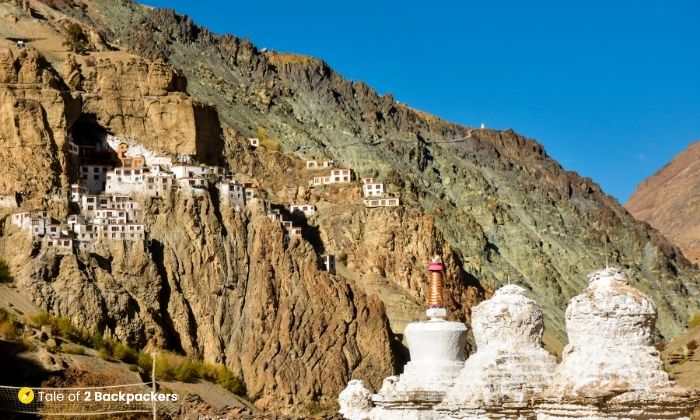
It was quite cold in the evening. A few young monks were there in the guest house running the place. They were quite jovial and we were soon exchanging stories with them. One of them had visited Tawang and we were quite happy to exchange stories with him.

One of the monks was a fan of Amitabh Bacchan and he was continuously sprouting dialogues from the Deewar movie. But he would not do that in front of the camera. It was so much fun talking to them. We learned about their studies and lifestyle, about the monastery and their life there. Winters are really harsh around these areas!
We had a simple dinner of Dal-chawal and then went to bed.
Exploring the Phugtal Monastery


The next morning, we went to the Phugtal Monastery. It was Monday and there was a special Pooja for the start of the week.

Phugtal monastery now houses around 100 monks. The monastery has 4 prayer rooms and a library containing old Buddhist manuscripts. There is also a chamber dedicated to Goddess Kali. There is a big stupa that is believed to contain the remains of Zangpo Lama.

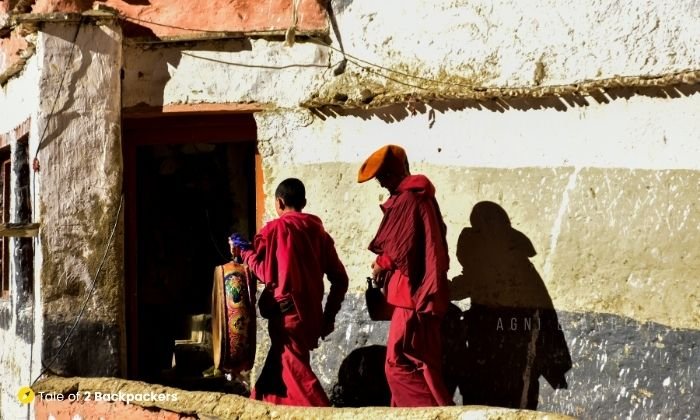
We explored the place, met the monks and talked with them. They were very helpful and offered us butter tea. It was a surreal feeling to be present at such a place. The feeling of the divine could be felt there. We could literally understand why the monks meditate at such places.
There is a village about half an hour’s walk from Phugtal Monastery. You can visit the village if you want.

Phugtal Monastery – Cha – Padum
After spending some time at the monastery, we finally decided to return. We started our trek around 11:30 and after 2 hours we were back at Chah. We started from Chah after having tea towards Padum.
Our dream of visiting the Phugtal monastery was finally complete. We returned with a contented feeling.

Where to stay at Phugtal Monastery?
There are 2 guest houses at Phugtal monastery, about half a kilometer before the monastery. The rooms are basic with attached bathrooms.
We do not have any contact for booking rooms there. We heard that they give rooms on the spot. Usually, you will get a room to stay in either of the guesthouses. We got a room when we reached after 2:30 PM.
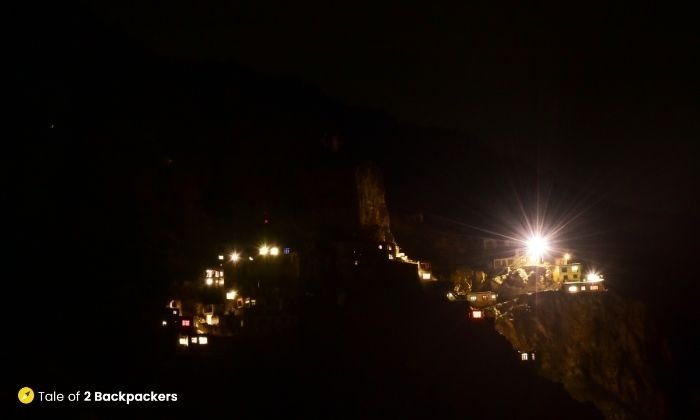
However, even if you do not get a room at the guesthouse, you will get a place to stay the night somewhere. The monks there will help you with stay and food.
The food provided is simple and vegetarian. But they are delicious.
You can also stay at Purne or Chah. A few homestays are available at both villages.

How many days are needed to do Phugtal Monastery Trek?
You will need at least 2 days to do Phugtal Monastery Trek. You can follow our itinerary and stay at the monastery guesthouse at night. Or you can stay at homestays at Purne or Chah village for the night and start the trek early the next morning and then return back.
You can also do the entire thing in one day, i.e start from Padum, do the Phugtal monastery trek and return back to Padum. But that will be quite hectic and you will definitely not be able to enjoy the trek or the place.
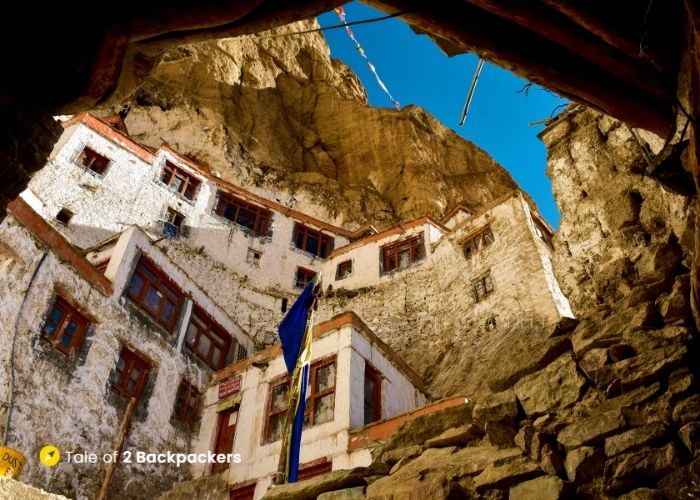
Phugtal Monastery Trek Tips
- Carry a water bottle during the trek. You will not get any water source on the trekking trail until you reach the Tsarap River side.
- If you want to photograph the monks, please ask for permission.
- Photography is usually not allowed inside the prayer rooms.
- While there is no entry fee to the monastery, you can donate whatever you want to the monastery fund.
- Carry a sunscreen of high SPF, as the sun tends to get quite harsh during the day.
- Carry a hat or cap to cover your head. You will thank me later for this tip! And also, your sunglasses.
- The evenings and nights tend to get quite cold. So, carry your jackets, scarf and socks.
- On your way back to Padum, you can visit Bardan Monastery and Muney Monastery. They falls on the road towards Padum.

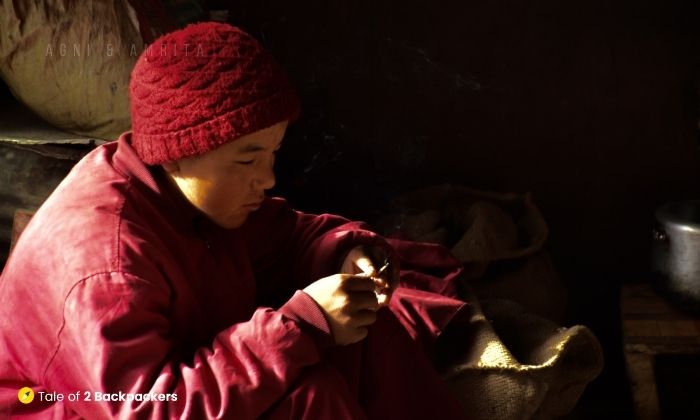
It is an experience to to visit the Phuktal Monastery. And the experience is entirely personal. We felt a sense of joy and contentment after completing the Phuktal Monastery trek. Your experience can be different.
Did you like the post? Please share your thoughts by commenting below. If you find this post useful, please share this with your family, friends and neighbours.
Pin it for a later read!
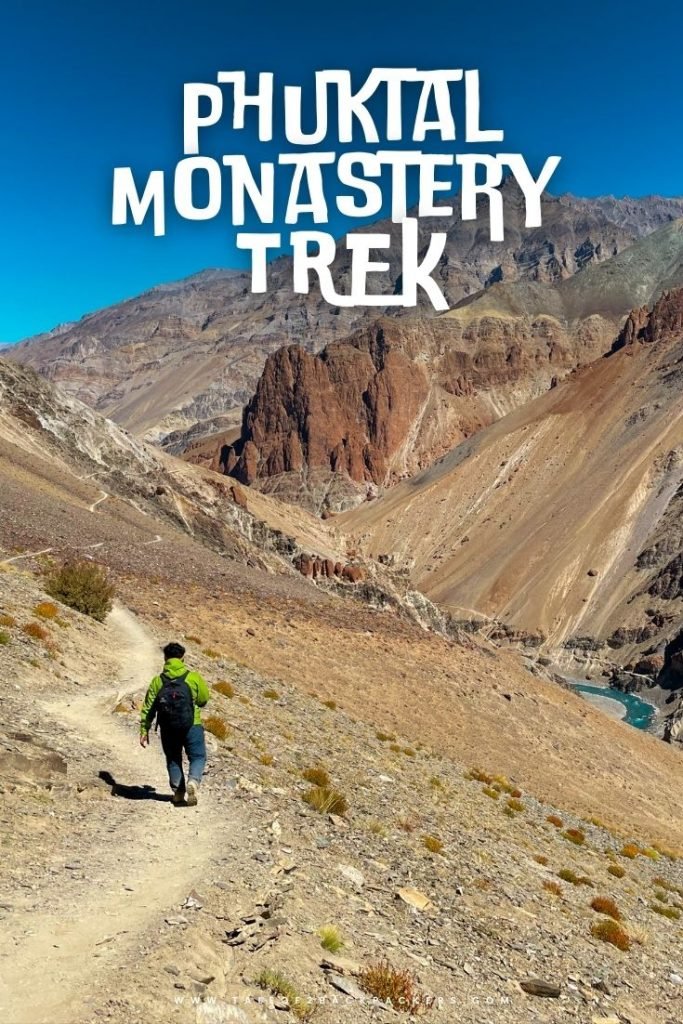

Have you visited Phuktal Monastery? Or for the matter, have you visited Zanskar? After an exciting trip to the Zanskar Valley and spending a considerable amount of time there, we are helping to arrange a trip to the Zanskar. If you need to plan your trip or require a Zanskar tour package, reach out to us by mail or drop a message at Instagram.

Now that you have read the post, please check our as well where we share videos of offbeat places and untold stories.

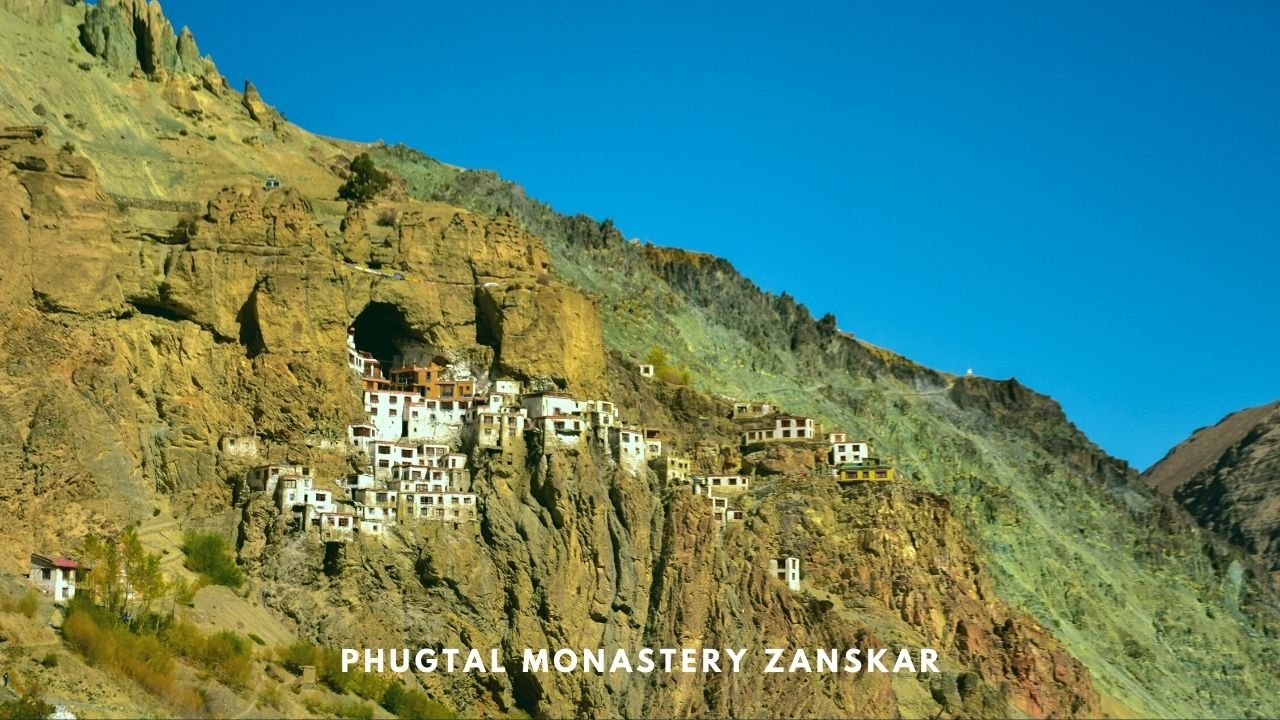

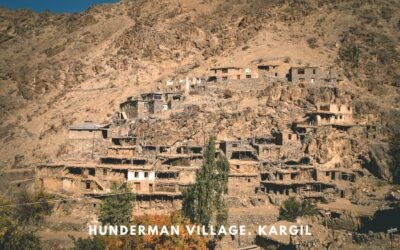

What a beautiful monastery! Its so fascinating and it so looks like Tiger monastery in Bhutan. Unfortunately when I was in Zanskar, I could not visit the monastery. I only saw this from far. Hopefully for my next visit.
You are right. Phugtal is quite similar to Taktshang Monastery in Bhutan. Even I thought so when we were there. I hope visit Phugtal next time you are in Zanskar.
I am so glad to have read your post. While I have visited many monasteries, this seems very unique! Lucky you!
YEs, Phugtal Monastery is quite unique. Thanks for the comment.
Zanskar valley and the monastery is truly a staircase to the heaven, the journey of trekking is beautiful and you have very well described each route and other conditions in the post.
Thank you!
My first reaction was is this place for real. I honestly wasn’t even aware of this place. It’s so beautiful and untouched, I wish I can visit there too.
Yes, Phugtal Monastery is simply beautiful. Thank you Manisha, for the comment.
This article is very informative for everyone who wants to trek at Phugal Monastery. Nicely written which accompanied by good pictures. I would love to visit Zanskar in the future.
Thank you so much, Pamela!
Never had the opportunity to explore this monastry in my earlier Ladakh visits.
The explanation is scintillating making me definitely not miss this place in my next visit.
Thank you so much, Sanjay.
Thanks for the very helpful and informative article.
I have been planning for the same for quite some time and hopefully will make it this summer.
By the way, what are the scope of travelling using public transport (not using personal car)?
Any information regarding this will be greatly appreciated by backpackers like me.
Thank you so much Rakesh. And we hope that you make it to Zanskar this summer. Public transport is a bit scarce in the region. You will get shared sumos or jeeps from Padum to Purne, but their frequency is very less. So you have to inquire from before. Otherwise, you can always hitchhike!
Hi..I’m planning to do this trek in first week of Feb. Can I do the single day trek, solo?
Yes, you can do the trek solo. The path is well defined. But if you want to do the trek in a single day, then you probably have to stay the previous night at either Purne or Cha village. Also winters are pretty harsh in Zanskar. So please take informed decision about the road and weather conditions before starting the trek.
Is it possible to join the monestary?
I guess you have to talk to the monastery authorities in what capacity you want to join. It is definitely possible to stay there for a few days or months.
Hi,
Can you let me know how many students are in the school currently? I am going there this month and planning to provide them some educational materials, but I need to know the nos. of students.
Thank you.
Well, we do not know the exact number. It is a commendable effort on your part!
Did you start the whole trip from Leh? Where is the best place to land. At which airport?
Thank you for your comment. Yes, we started the trip from Leh. Leh airport is the place where you might land for the trip. However, if you want to start from Manali side, then you have to land at Chandigarh airport. You may please check our blog on “How to reach Zanskar Valley” to know more. Thanks… 🙂